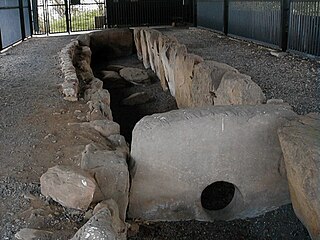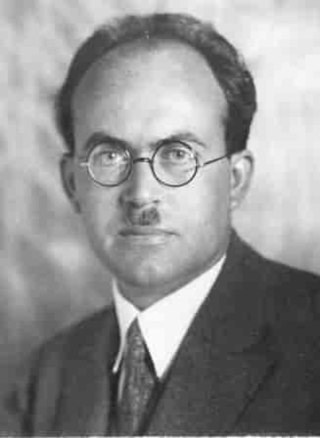
The Únětice culture, Aunjetitz culture or Unetician culture is an archaeological culture at the start of the Central European Bronze Age, dated roughly to about 2300–1600 BC. The eponymous site for this culture, the village of Únětice, is located in the central Czech Republic, northwest of Prague. There are about 1,400 documented Únětice culture sites in the Czech Republic and Slovakia, 550 sites in Poland, and, in Germany, about 500 sites and loose finds locations. The Únětice culture is also known from north-eastern Austria, and from western Ukraine.

The Funnel(-neck-)beaker culture, in short TRB or TBK was an archaeological culture in north-central Europe. It developed as a technological merger of local neolithic and mesolithic techno-complexes between the lower Elbe and middle Vistula rivers. These predecessors were the (Danubian) Lengyel-influenced Stroke-ornamented ware culture (STK) groups/Late Lengyel and Baden-Boleráz in the southeast, Rössen groups in the southwest and the Ertebølle-Ellerbek groups in the north. The TRB introduced farming and husbandry as a major source of food to the pottery-using hunter-gatherers north of this line.

Approximately 120–150 Neolithic earthworks enclosures are known in Central Europe. They are called Kreisgrabenanlagen in German, or alternatively as roundels. They are mostly confined to the Elbe and Danube basins, in modern-day Germany, Austria, Czech Republic, Slovakia, as well as the adjacent parts of Hungary and Poland, in a stretch of Central European land some 800 km (500 mi) across. They date to the first half of the 5th millennium BC; they are associated with the late Linear Pottery culture and its local successors, the Stroke-ornamented ware and Lengyel cultures. The best known and oldest of these Circular Enclosures is the Goseck circle, constructed c. 4900 BC.

The Rössen culture or Roessen culture is a Central European culture of the middle Neolithic.
Central Germany is an economic and cultural region in Germany. Its exact borders depend on context, but it is often defined as being a region within the federal states of Saxony, Thuringia and Saxony-Anhalt, or a smaller part of this region, such as the metropolitan area of Leipzig and Halle plus the surrounding counties.
The Frankleben hoard is a significant hoard deposit of the European Bronze Age, associated with the Unstrut group (associated with the Tumulus or early Urnfield culture. The site is in the Geisel valley, formed by a minor tributary of the Saale River. It was discovered in 1946 in a brown coal pit near Frankleben, now a part of Braunsbedra municipality, Saxony-Anhalt, Germany.

The Züschen tomb is a prehistoric burial monument, located between Lohne and Züschen, near Fritzlar, Hesse, Germany. Classified as a gallery grave or a Hessian-Westphalian stone cist, it is one of the most important megalithic monuments in Central Europe. Dating to the late 4th millennium BC, it belongs to the Late Neolithic Wartberg culture. The presence of incised carvings, comparable to prehistoric rock art elsewhere in Europe, is a striking feature of Wartberg culture tombs, known so far only from Züschen and from tomb I at Warburg.
The Lohra tomb was a megalithic monument outside Lohra near Marburg in north central Hesse, Germany. It is one of the lesser known among its type in Central Europe. It dates to the late Neolithic, probably just after 3000 BC. It belongs to the gallery graves of the Wartberg culture, but is unique among them because of its rich ceramic assemblage.
The Wartberg culture, sometimes: Wartberg group (Wartberggruppe) or Collared bottle culture (Kragenflaschenkultur) is a prehistoric culture from 3,600 -2,800 BC of the later Central European Neolithic. It is named after its type site, the Wartberg, a hill near Niedenstein-Kirchberg in northern Hesse, Germany.

Havelland culture was a neolithic archaeological culture in northeastern Germany, centered at Havelland, with contacts to the Globular Amphora culture. It was characterized by cups with handles, amphoras with to handles, and barrels and dishes with carpet-like decorations. The dead were buried unburned. The Havelland people were farmers and breeders.

The Mitteldeutsche Zeitung is a regional daily newspaper for southern Saxony-Anhalt, Germany. Published in Halle with several local versions, the paper is owned by M. DuMont Schauberg, Cologne.
The Salzmünde Group or Salzmünde Culture is the name for a late group from the Funnelbeaker culture in central Saale-Elbe region of Germany, which existed between 3400 and 3000 BC during the Neolithic period.

Paul Grimm was a German prehistorian and also a pioneer of Medieval archaeology, especially of the excavation of abandoned villages and castles. Grimm worked on various periods, but mainly in central Germany – the names of two important Neolithic archaeological cultures in the area, the Baalberge group and the Salzmünde group derive from him. His comprehensive excavations at Hohenrode and Tilleda were important milestones in the history of German archaeology.
Clay drums are ceramic objects in the shape of an hourglass, eggcup or tulip with no feet, with a ring of up to 15 holes at either end. They are typical of southeastern groups within the Funnelbeaker culture, particularly the Walternienburg-Bernburg group, but are also found in southern successor groups of the Michelsberg culture. They are often well decorated and, unlike collar bottles, are often found completely shattered.
Walternienburg-Bernburger Kultur refers to a mid-neolithic culture which was focused on the area of modern Saxony-Anhalt, the Thuringian Basin and Franconia from 3200 to 2800 BC. It consisted of two regional groups, Walternienburg and Bernburg which interacted closely with each other. Both are named after burial sites in Saxony-Anhalt. Alfred Götze identified the Bernburg type in 1892 and the Walternienburg in 1911. Nils Åberg linked them together as the Walternienburg-Bernburg Culture in 1918, as two closely connected or completely co-extensive cultures. This suggestion is no longer valid, however, since the two cultures have clearly distinct funerary and burial practices. The earlier large stone graves attributed to the Walternienburg culture are today assigned to the Tiefstichkeramik culture and the shape of pottery belonging to the Walternienburg culture shows that it was in the Tiefstichkeramik tradition.

The Fritzens-Sanzeno culture is an archaeological culture attested in the late Iron Age, from ca. 500 BC until the end of the first century BC, in the Alpine region of Trentino and South Tyrol; in the period of maximum expansion it also reached the Engadin region to the west and East Tyrol. It takes its name from the two towns of Fritzens (Austria) and Sanzeno (Trentino), where important archaeological excavations were carried out at the beginning of the 20th century.
Hans Hahne was a German physician and prehistorian.

Hans Reinerth was a German archaeologist. He was a pioneer of Palynology and modern settlement archaeology, but is controversial because of his role before and during the period of National Socialism.
Edwin Werner is a German musicologist and Handel scholar.
Horst Förster was a German conductor, choirmaster, violinist and university teacher. In 1952, he was appointed the youngest General Music Director of the GDR in the Landestheater Eisenach. Afterwards, he was chief conductor of the Philharmonisches Staatsorchester Halle and the Singakademie Halle (1956–1964) as well as the Dresden Philharmonic (1964–1966).












